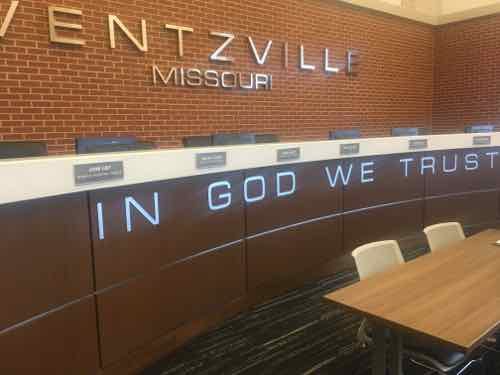Opinion: ‘In God We Trust’ Should Be Removed From Wentzville’s City Hall
Last week we were in Wentzville buying a newer car so we decided to make a quick detour to see the controversial motto inside the recently opened Wentzville City Hall.

Lawsuits to have this motto removed from currency have failed due to lack on burden, but in a legislative chamber where all citizens should feel welcomed this should not be allowed. It’s unquestionably religious.
The motto IN GOD WE TRUST was placed on United States coins largely because of the increased religious sentiment existing during the Civil War. Secretary of the Treasury Salmon P. Chase received many appeals from devout persons throughout the country, urging that the United States recognize the Deity on United States coins. From Treasury Department records, it appears that the first such appeal came in a letter dated November 13, 1861. It was written to Secretary Chase by Rev. M. R. Watkinson, Minister of the Gospel from Ridleyville, Pennsylvania (US Treasury)
So the motto began on coins because of “religious sentiment” at the beginning of the Civil War. Yes, but “In God We Trust” is the national motto, you might say. Sure — since 1956 during the Cold War. Another great period in US history — U.S. Senator Joseph R. McCarthy was trying to find all the “reds” in Hollywood. The same period “under God” was added to the pledge of allegiance. For most of the nation’s history the national motto was E Pluribus Unum — out of many, one.
Although “In God We Trust” is the official motto, “E Pluribus Unum” has long been acknowledged as a de facto national motto. After all, it is on the Great Seal of the United States, which was adopted in 1782. Moreover, in the 1770s and ’80s Congress opposed a theistic motto for the nation, and many of the founders worked hard to prevent one from being established.
In July 1776, almost immediately after signing the Declaration of Independence, John Adams, Benjamin Franklin, and Thomas Jefferson were tasked with designing a seal and motto for the new nation. In August John Adams wrote to his wife, Abigail, that he had proposed the “Choice of Hercules” as the image for the seal. Adams believed that individuals should choose to lead moral personal lives and to devote themselves to civic duty, and he preferred a secular allegory for that moral lesson.
The other two committee members proposed images that drew on Old Testament teachings, but neither shared the beliefs of those today who assert the role of God in our national government. Benjamin Franklin, a deist who did not believe in the divinity of Christ, proposed “Moses lifting up his Wand, and dividing the Red Sea, and Pharaoh, in his Chariot overwhelmed with the Waters.” This motto he believed, captured the principle that “Rebellion to Tyrants is Obedience to God.”
Thomas Jefferson, who later created his own Bible by cutting out all mentions of the miracles of Jesus Christ (as well as his divine birth and resurrection), envisioned “The Children of Israel in the Wilderness, led by a Cloud by day, and a Pillar of Fire by night, and on the other Side Hengist and Horsa, the Saxon Chiefs, from whom We claim the Honour of being descended and whose Political Principles and Form of Government We have assumed.” Of all of his accomplishments, Jefferson selected just three for his tombstone, one of which was writing the Virginia Statute for Religious Freedom, which established a separation of church and state.
The three men worked in consultation with an artist, Eugène Pierre Du Simitière, who rejected all of the ideas of the three committee members. His own first attempt was also rejected by Congress. It would take years and several more committees before Congress would approve the final design, still in use today, of an American bald eagle clutching thirteen arrows in one talon and an olive branch in the other.
Only the motto “E Pluribus Unum” (“from many, one”) survived from the committee on which Adams, Jefferson, and Franklin had served. All had agreed on that motto from the beginning.The current motto, “In God We Trust,” was developed by a later generation. It was used on some coinage at the height of religious fervor during the upheaval of the Civil War.
It was made the official national motto in 1956, at the height of the Cold War, to signal opposition to the feared secularizing ideology of communism.
In other words, “In God We Trust” is a legacy of founders, but not the founders of the nation. As the official national motto, it is a legacy of the founders of modern American conservatism — a legacy reaffirmed by the current Congress. (Ohio State University)
Here are the results of the recent non-scientific Sunday Poll:
Q: Agree or disagree: The phrase ‘In God We Trust’ is on our currency, so I don’t have a problem with it on the dais of the Wentzville Board of Alde
- Strongly agree 7 [24.14%]
- Agree 2 [6.9%]
- Somewhat agree 0 [0%]
- Neither agree or disagree 2 [6.9%]
- Somewhat disagree 3 [10.34%]
- Disagree 3 [10.34%]
- Strongly disagree 11 [37.93%]
- Unsure/No Answer 1 [3.45%]
It sickens me some are so insecure about their religious beliefs they’re only happy if they force them on the rest of us.
— Steve Patterson